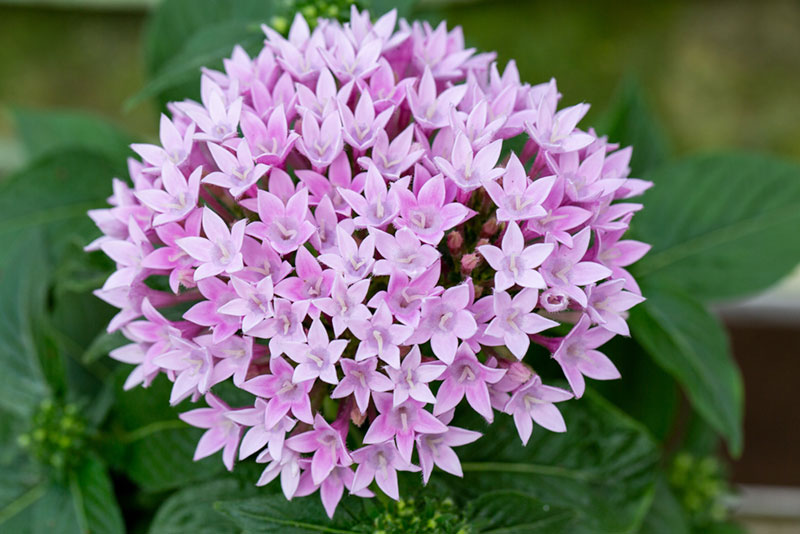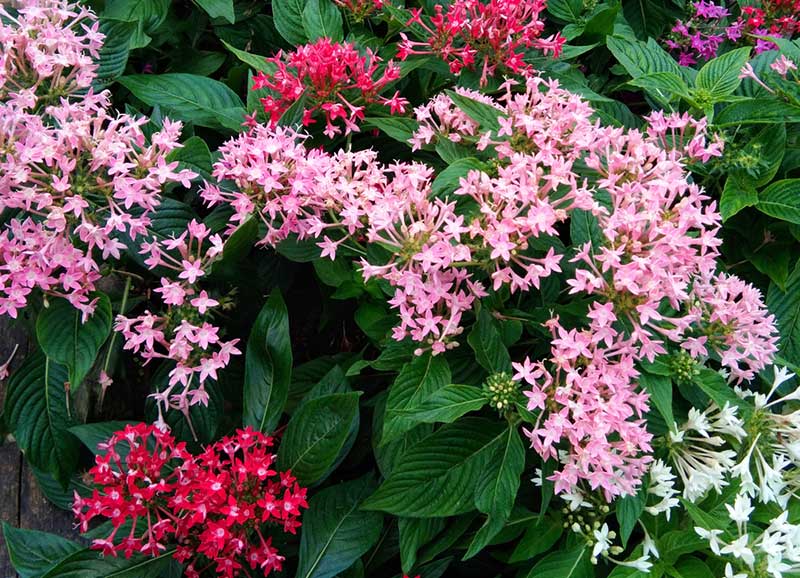Pentas (Pentas lanceolata), also called Egyptian stars, produce clusters of tiny star-shaped flowers on branching, medium green foliage.
While they are technically a tender perennial that can survive for years in USDA plant hardiness zones 10 and 11, they are grown as summer annuals throughout much of the United States.
These plants create a profusion of color from spring until fall and attract both hummingbirds and butterflies. Bloom color ranges from pure white and pastel pinks to deep rose, red and lavender with a few bicolors, too.
Pentas are relatively easy to care for and can be grown in pots or containers as well as in the soil.
Light and Temperature Requirements
Plant your penta seedlings in the spring after the danger of frost has passed. These tender perennials cannot tolerate frost.
Choose a location that receives full sun when planting your pentas. Pentas require 6 to 8 hours of direct sunlight a day, but the hours do not need to be consecutive. Three to four hours of morning light, noonday shade and another three or four hours of direct sunlight in the afternoon will suit them just fine. They will also tolerate partial shade, particularly in southern climates. Those grown in partial shade in northern climates may become tall and leggy as they stretch for the sun and blooming may be inhibited.

Watering
Pentas grown in the ground require 1 to 2 inches of rainfall a week. Watch for signs of wilting or check the soil to determine if your pentas require supplemental watering. If the soil is dry to the touch 1-inch below the surface your pentas need watering. Window boxes and containers require more frequent water as they tend to dry out quickly. Pentas grown in containers may need daily watering during the heat of summer. Water them thoroughly until water runs freely through the bottom of the container.
Soil & Fertilizing
Prepare an area for pentas in the flowerbed by turning the soil to a depth of 8 inches. Remove any rocks, sticks or other debris from the soil. Add a 2- to 3-inch layer of compost or well-rotted manure over the area and work it in well with the existing soil.
Dig holes twice the size of the root ball of your plants and position them into the hole, so they rest at their original growing depth. Firm the soil around the roots to remove air pockets and water them well.
Mix equal parts peat moss, compost and vermiculite or perlite to make a lightweight potting mixture for containers. All-purpose potting soil is too heavy for containers and compacts easily with repeated watering.
Fertilize your pentas with a water-soluble fertilizer every 10 to 14 days during the summer. This is especially important for container-grown pentas as repeated watering causes fertilizer to leach through the bottom of the pot.
Deadheading and Pruning
Removing old flowers as soon as they fade will keep your pentas looking good and will trick the plant into thinking it has not produced enough seeds to reproduce. This will force energy into new flower production. You can also prune the plant to keep its shape at any time by cutting unruly foliage back to the overall shape of the plant.
Pentas grown as perennials can reach heights of 6 feet or more and may require pruning to keep them in shape. Although you can trim back individual branches at any time during the summer, major pruning should be done in the fall after blooming has ceased. You can even cut your pentas back to within a few inches from the ground to rejuvenate them and create a lush, compact shrub the following year.

Propagation
Penta cuttings can be rooted in water or dipped in rooting powder and potted in moist potting medium to produce new plants identical to the parent.
Growing Pentas from Seed
You can grow pentas from seed, but you will need to start them inside 7 to 9 weeks before the last expected frost in your area if you want them to bloom all summer.
- Fill plant trays or containers with moistened seed starter.
- Place the penta seeds on the top of the starter and press them in lightly. Do not cover the seeds as they need light to germinate.
- Mist lightly to moisten the seeds and seed starter.
- Cover the trays with plastic wrap to hold in moisten.
- Place the trays on a heating mat or in a location, such as the top of the water heater, that will provide gentle bottom heat. Maintain a soil temperature of 75 degrees Fahrenheit for optimal germination.
- Keep the soil moist, but not soggy, until seedlings emerge in 14 to 21 days.
- Move the seedlings to an area that receives bright light or place them under plant lights with 16 hours of light and 8 hours of darkness per day.
- Transplant your seedlings to individual pots when they develop the second set of true leaves.
- Transplant them to their outside location once all danger of frost has passed in your area.
Mulching
Pentas benefit from mulching when grown in the soil. Spread a 2- to 3-inch layer of mulch around the areas under your pentas. Mulch helps to control weeds, maintains moisture and makes your garden more attractive.



